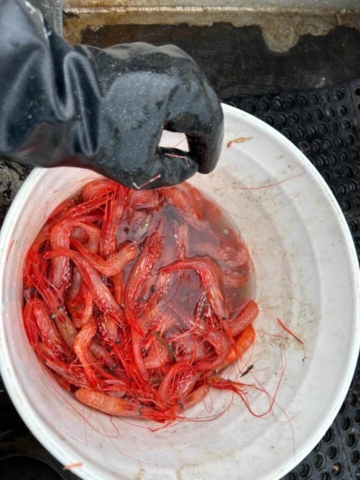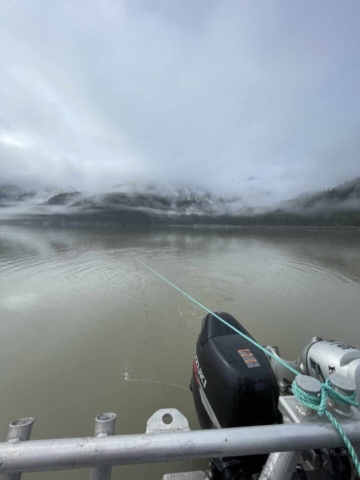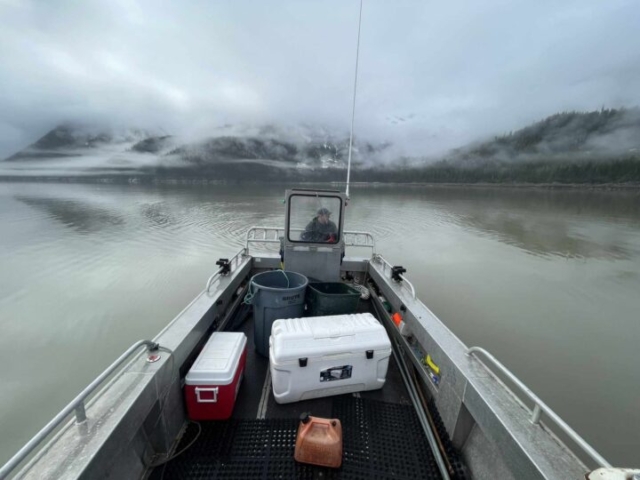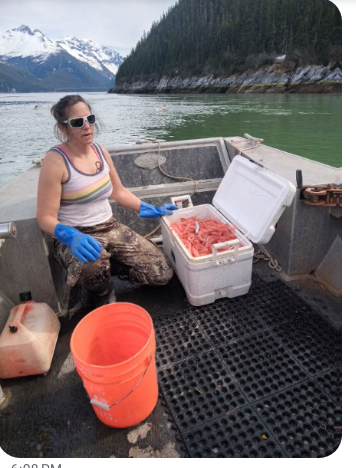Although I’ve been out shrimping once with Mike in Craig, I really wasn’t sure how to deploy and retrieve a trawl on my own. I bought a trawl from my old trolling buddy Matt last year, but hadn’t fished it yet. Nick had offered to go out with me to teach me when I took him and Jesse trapping this winter, and yesterday we went. His friend Amanda (who I knew) went along to look for black bears while we were shrimping.
We were to meet Nick at the launch ramp at 7:30 am. We all showed up early. It was a bluebird day and calm seas. All of us were itching to get out on the water.
We ran in Nick’s sweet 20’ (or so) long landing craft down the channel to the shrimping spot about 40 minutes away. If I understood him right, he got the boat because the owner only listed it by its brand name, and people didn’t realize it was a landing craft. Nick was able to get it—motors and all—for only $20,000 about 8 years ago from the seller in Pelican, who just had it to transport supplies to build his cabin. I love stories like that. It’s a great platform for doing about everything on the water except staying dry since it has no cabin.
The shrimp trawl consists of a net, otter boards, lead lines, and tow line. The otter trawl net has two boards on each side of the net that keep the net mouth open. The net opening is about 12 feet wide. The top of the net has floats, and the bottom has a light link chain to tickle the bottom and make the shrimp jump up off the bottom and into the net. To each board is tied a 100-foot lead line with a carabiner on the other end. The net end of the towline has a swivel with a 10 lb cannonball on one side of the swivel, and a carabiner tied to the end of the towline that is snapped onto the other side of the swivel.
The carabiners from the door lead lines are clipped to the top of the swivel alongside the towline carabiner, not the bottom where the cannonball is. Nick said if you clip them to the cannonball side, the net leads will twist. Good to know.
Our tow speed was 1.3 knots. We were fishing over a flat mud bottom, which is what a shrimper is looking for.
I helped Nick deploy the net while Amanda drove the boat. We stood along the side of the boat in the rear, with each of us holding a door and the net between us. Amanda put the boat in gear, and we each let our boards over the side, then slowly let out our lead lines until the net was behind the boat about 20 feet. Then we rotated back around the stern. Nick had us pull our lead lines up near the outboard so he could visually see the net was open and working properly. Another important step, he said many times. Then I handed him my lead line, and he, alone, let the net descend slowly, under tension, behind the boat.
While he was letting the lead lines out, I found the carabiners on each end of the lead lines and snapped them to the top of the swivel at the end of the towline. When the net was out to the end of the lead lines, I handed the towline up to Nick and fed the towline out of the barrel to him, trying to unravel any kinks before they got to him. There was about 1,200 feet of towline, and we used most of it each tow.
We fished the net in water ranging from about 250 feet deep up to about 150 feet. My friend Matt, who fished the same location with the net I bought from him, said he fished in 40 to 60 feet, which was surprisingly shallow to me for some reason. At 250 feet, we used about 1,000 feet of towline; a little less towline if dragging shallower. We’d gauge that the towline length was sufficient by watching to see that the towline twitched now and then, indicating the boards were bouncing on the bottom.
We towed for between 30 minutes and an hour. So lots of time to drink coffee, chat, take in the spectacular snow-covered mountains around us, and look for a black bear for Amanda on the beaches.
Hauling the net was simple. The boat was shifted to neutral, the towline walked from the tow bar in the rear to the bow of the boat, and the person hauling the towline stacked it back into the garbage can while the driver tried to just keep up with the line hauler so the hauler wasn’t having to pull the boat to the net. When most of the line was in the boat and the net was directly under the boat, Nick started his Honda pot puller and hauled up the rest of the line with it—except for the one time I did the hauling and pulled the line by hand all the way to the boat, which wasn’t too difficult.
Once the net was alongside the boat, we’d swish it up and down in the water several times to rinse off as much mud as possible. Then, depending on the haul, one or two of us would grab the net and bring it over the side and into the cooler, untie the cod end, and dump the catch into the cooler.
Of course, we caught more than shrimp in the net. The other sealife caught included eel pouts (the most numerous bycatch), sculpin, moonfish, lumpsucker, starry flounder, other unidentified juvenile flatfish, crab, hooligan, pollock, rock shrimp, and small sea stars the size of Christmas cookies. Basically, a marine biologist’s or 9-year-old’s dream.
After returning the bycatch to the ocean, we got into a rhythm where Amanda would take over repeatedly rinsing the shrimp (side stripe, coon stripe, and pink shrimp), and Nick and I would get the net ready to fish again.
We made three or four tows for the day and got plenty of shrimp, especially since Nick didn’t want any because he still had shrimp from last year to eat. We didn’t see any bears, so Amanda’s rifle stayed cased. She and I headed shrimp while Nick drove the 40 minutes back to the dock in 60-degree weather and calm seas.
We barely made a dent processing all the shrimp by the time we pulled in to the ramp. Once up the ramp, Amanda handed the cooler of shrimp down to me, and we each took a bucket of shrimp, then said our goodbyes after a wonderful day. Nick told me he wanted to give me some surplus smoked black cod he’d just finished, and I said I’d be right over. I ran home first to grab some gallon Ziplocs. I then went directly to the Salvation Army store to give Mike a gallon bag of shrimp before the store closed. At Nick’s, I grabbed the smoked black cod and thanked him again, then ran just up the block to Kurt’s to give him the other gallon bag of shrimp and tell him all about the day over a beer.
Once I got home, Sara helped me head the shrimp, which was very welcome. We saved the heads for Amanda, who was going to make stock with them. I normally might do the same, but like Nick’s shrimp, my freezer has a ton of both venison and shrimp stock already, so I’m glad she will use them. We put the tails into the fridge overnight, as Nick was told by a shrimp peeler machine manufacturer that leaving the tails overnight will allow something to happen that will make them easier to peel the next day.
I was sore when I got home. Knees were stiff. Hip a little sore. And another day of feeling so lucky I live here and never wanting to leave.




